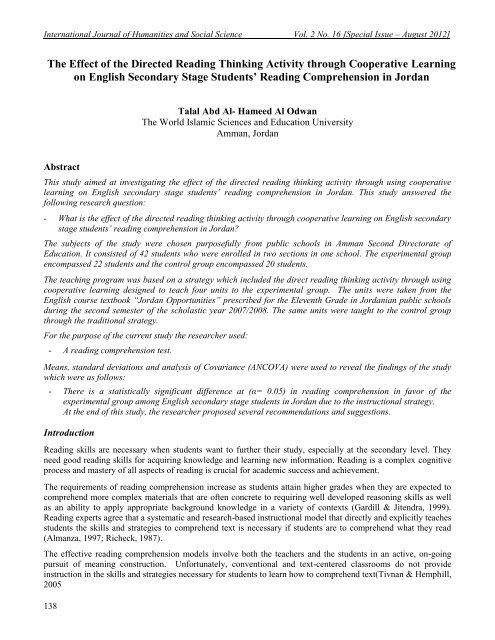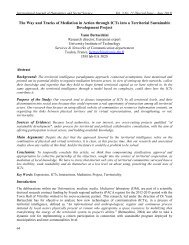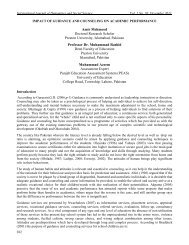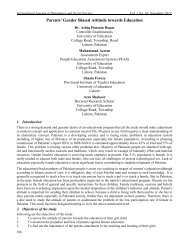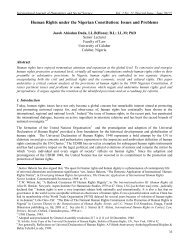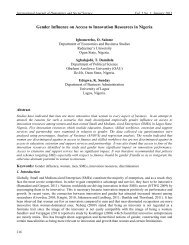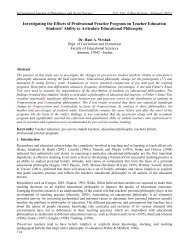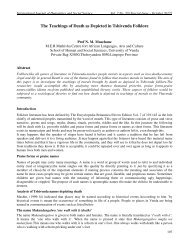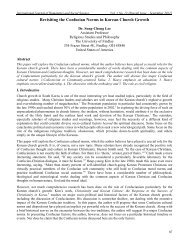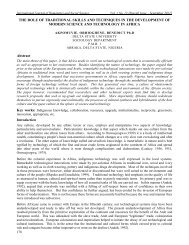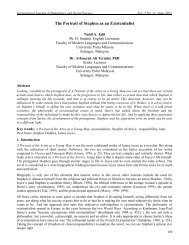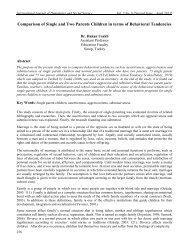The Effect of the Directed Reading Thinking Activity through ...
The Effect of the Directed Reading Thinking Activity through ...
The Effect of the Directed Reading Thinking Activity through ...
Create successful ePaper yourself
Turn your PDF publications into a flip-book with our unique Google optimized e-Paper software.
International Journal <strong>of</strong> Humanities and Social Science Vol. 2 No. 16 [Special Issue – August 2012]<br />
<strong>The</strong> <strong>Effect</strong> <strong>of</strong> <strong>the</strong> <strong>Directed</strong> <strong>Reading</strong> <strong>Thinking</strong> <strong>Activity</strong> <strong>through</strong> Cooperative Learning<br />
on English Secondary Stage Students’ <strong>Reading</strong> Comprehension in Jordan<br />
Talal Abd Al- Hameed Al Odwan<br />
<strong>The</strong> World Islamic Sciences and Education University<br />
Amman, Jordan<br />
Abstract<br />
This study aimed at investigating <strong>the</strong> effect <strong>of</strong> <strong>the</strong> directed reading thinking activity <strong>through</strong> using cooperative<br />
learning on English secondary stage students’ reading comprehension in Jordan. This study answered <strong>the</strong><br />
following research question:<br />
- What is <strong>the</strong> effect <strong>of</strong> <strong>the</strong> directed reading thinking activity <strong>through</strong> cooperative learning on English secondary<br />
stage students’ reading comprehension in Jordan?<br />
<strong>The</strong> subjects <strong>of</strong> <strong>the</strong> study were chosen purposefully from public schools in Amman Second Directorate <strong>of</strong><br />
Education. It consisted <strong>of</strong> 42 students who were enrolled in two sections in one school. <strong>The</strong> experimental group<br />
encompassed 22 students and <strong>the</strong> control group encompassed 20 students.<br />
<strong>The</strong> teaching program was based on a strategy which included <strong>the</strong> direct reading thinking activity <strong>through</strong> using<br />
cooperative learning designed to teach four units to <strong>the</strong> experimental group. <strong>The</strong> units were taken from <strong>the</strong><br />
English course textbook “Jordan Opportunities” prescribed for <strong>the</strong> Eleventh Grade in Jordanian public schools<br />
during <strong>the</strong> second semester <strong>of</strong> <strong>the</strong> scholastic year 2007/2008. <strong>The</strong> same units were taught to <strong>the</strong> control group<br />
<strong>through</strong> <strong>the</strong> traditional strategy.<br />
For <strong>the</strong> purpose <strong>of</strong> <strong>the</strong> current study <strong>the</strong> researcher used:<br />
- A reading comprehension test.<br />
Means, standard deviations and analysis <strong>of</strong> Covariance (ANCOVA) were used to reveal <strong>the</strong> findings <strong>of</strong> <strong>the</strong> study<br />
which were as follows:<br />
- <strong>The</strong>re is a statistically significant difference at (α= 0.05) in reading comprehension in favor <strong>of</strong> <strong>the</strong><br />
experimental group among English secondary stage students in Jordan due to <strong>the</strong> instructional strategy.<br />
At <strong>the</strong> end <strong>of</strong> this study, <strong>the</strong> researcher proposed several recommendations and suggestions.<br />
Introduction<br />
<strong>Reading</strong> skills are necessary when students want to fur<strong>the</strong>r <strong>the</strong>ir study, especially at <strong>the</strong> secondary level. <strong>The</strong>y<br />
need good reading skills for acquiring knowledge and learning new information. <strong>Reading</strong> is a complex cognitive<br />
process and mastery <strong>of</strong> all aspects <strong>of</strong> reading is crucial for academic success and achievement.<br />
<strong>The</strong> requirements <strong>of</strong> reading comprehension increase as students attain higher grades when <strong>the</strong>y are expected to<br />
comprehend more complex materials that are <strong>of</strong>ten concrete to requiring well developed reasoning skills as well<br />
as an ability to apply appropriate background knowledge in a variety <strong>of</strong> contexts (Gardill & Jitendra, 1999).<br />
<strong>Reading</strong> experts agree that a systematic and research-based instructional model that directly and explicitly teaches<br />
students <strong>the</strong> skills and strategies to comprehend text is necessary if students are to comprehend what <strong>the</strong>y read<br />
(Almanza, 1997; Richeck, 1987).<br />
<strong>The</strong> effective reading comprehension models involve both <strong>the</strong> teachers and <strong>the</strong> students in an active, on-going<br />
pursuit <strong>of</strong> meaning construction. Unfortunately, conventional and text-centered classrooms do not provide<br />
instruction in <strong>the</strong> skills and strategies necessary for students to learn how to comprehend text(Tivnan & Hemphill,<br />
2005<br />
138
<strong>The</strong> Special Issue on Commerce and Social Science © Centre for Promoting Ideas, USA www.ijhssnet.com<br />
However, practices in Jordanian schools showed that most students’ reading abilities are not good enough to do<br />
so. For students, much <strong>of</strong> <strong>the</strong> reading will be to learn assigned material or accomplish school assignment. All<br />
students get information from materials <strong>the</strong>y read and yet many <strong>of</strong> <strong>the</strong>m do not read everything for <strong>the</strong> same<br />
reason or in <strong>the</strong> same way or at <strong>the</strong> same rate (Al Debes, 2005).<br />
Many researchers have been interested in doing research to investigate appropriate reading strategies to help<br />
students who have better understanding when <strong>the</strong>y read in Jordan. <strong>The</strong> results <strong>of</strong> some studies show that some<br />
strategies are successful with a particular group <strong>of</strong> students but some are not (Salameh, 2008; Abu Khater, 2006;<br />
Al Debes, 2005).<br />
As a result, <strong>the</strong> researcher is trying to use a combination <strong>of</strong> two strategies toge<strong>the</strong>r, <strong>the</strong> directed reading thinking<br />
activity and <strong>the</strong> cooperative learning, as one strategy to teach Jordanian secondary stage students reading, to<br />
enhance students’ achievement in reading comprehension .<br />
Statement <strong>of</strong> <strong>the</strong> Problem<br />
This study aimed at investigating <strong>the</strong> effect <strong>of</strong> <strong>the</strong> directed reading thinking activity <strong>through</strong> using cooperative<br />
learning on English secondary stage students’ reading comprehension in Jordan.<br />
Question <strong>of</strong> <strong>the</strong> study<br />
This study aimed to answer <strong>the</strong> following research question:<br />
1. What is <strong>the</strong> effect <strong>of</strong> <strong>the</strong> directed reading thinking activity <strong>through</strong> cooperative learning on English<br />
secondary stage students’ reading comprehension in Jordan?<br />
Research Hypo<strong>the</strong>ses<br />
To answer <strong>the</strong> questions <strong>of</strong> <strong>the</strong> study, <strong>the</strong> researcher tested <strong>the</strong> following statistical hypo<strong>the</strong>ses:<br />
1. <strong>The</strong>re is no statistically significant difference at (α= 0.05) in reading comprehension among English<br />
secondary stage students due to <strong>the</strong> instructional strategy (<strong>Directed</strong> reading thinking activity <strong>through</strong><br />
cooperative learning compared with conventional strategy).<br />
Significance <strong>of</strong> <strong>the</strong> Study<br />
<strong>The</strong> combination <strong>of</strong> <strong>the</strong> two strategies provide fur<strong>the</strong>r support for <strong>the</strong> directed reading thinking activity <strong>through</strong><br />
cooperative learning practice by projecting its content and procedures to teach real situations at <strong>the</strong> secondary<br />
level in Jordan.<br />
<strong>The</strong> Directorate <strong>of</strong> English language Curricula may introduce a variety <strong>of</strong> teaching and learning activities based<br />
on <strong>the</strong> directed reading thinking activity <strong>through</strong> cooperative learning stressing on reading comprehension <strong>through</strong><br />
students’ textbook, teachers’ guide and train teachers how to apply <strong>the</strong>m inside <strong>the</strong> classroom.<br />
<strong>The</strong> findings <strong>of</strong> <strong>the</strong> study should be <strong>of</strong> particular significance to <strong>the</strong> teachers who participated in this study and to<br />
Jordanian teachers who teach in similar situations as <strong>the</strong>y select instructional strategy and engage in <strong>the</strong> decisionmaking<br />
process related to reading comprehension instruction. It is hoped that this study may help Jordanian<br />
teachers use effective means for teaching reading comprehension.<br />
Operational Definitions<br />
For <strong>the</strong> purpose <strong>of</strong> <strong>the</strong> study, <strong>the</strong> following terms are defined operationally:<br />
1. <strong>Directed</strong> <strong>Reading</strong> <strong>Thinking</strong> <strong>Activity</strong>: A strategy that is intended to develop students’ ability to read critically<br />
and reflectively. <strong>The</strong> directed reading thinking activity attempts to equip readers with <strong>the</strong> ability to determine <strong>the</strong><br />
purposes <strong>of</strong> reading, <strong>the</strong> ability to extract, comprehend, and assimilate information, <strong>the</strong> ability to make predictions<br />
to examine reading materials based on <strong>the</strong> purposes <strong>of</strong> reading, <strong>the</strong> ability to pass judgments, and finally <strong>the</strong><br />
ability to make decisions based upon information gleaned from reading.<br />
2. Cooperative Learning: is a teaching strategy in which small groups <strong>of</strong> four or five students <strong>of</strong> different levels<br />
<strong>of</strong> ability, use a variety <strong>of</strong> learning activities to improve <strong>the</strong>ir understanding <strong>of</strong> a subject.<br />
139
International Journal <strong>of</strong> Humanities and Social Science Vol. 2 No. 16 [Special Issue – August 2012]<br />
Each member <strong>of</strong> <strong>the</strong> group is responsible not only for learning what is taught but also for helping group mates<br />
learn; thus creating an atmosphere <strong>of</strong> achievement. Students work <strong>through</strong> <strong>the</strong> assignment until all group members<br />
successfully understand and complete it.<br />
3. <strong>Directed</strong> <strong>Reading</strong> <strong>Thinking</strong> <strong>Activity</strong> <strong>through</strong> Cooperative<br />
Learning: Two strategies toge<strong>the</strong>r, <strong>the</strong> directed reading thinking activity and <strong>the</strong> cooperative learning, are<br />
intended to develop students’ ability to read critically and reflectively were designed for <strong>the</strong> purpose <strong>of</strong> this study<br />
to teach reading skills as one strategy.<br />
4. <strong>Reading</strong> comprehension: is a process that requires how to decode <strong>through</strong> <strong>the</strong> development <strong>of</strong> an extensive<br />
repertoire <strong>of</strong> sight words, learning <strong>the</strong> meanings <strong>of</strong> vocabulary words encountered in <strong>the</strong> texts, and learning how<br />
to abstract meaning from text. It represents how well readers understand literal comprehension which concentrates<br />
on explicit meaning and inferential comprehension which concentrates on implicit meaning in <strong>the</strong> reading text.<br />
Limitations <strong>of</strong> <strong>the</strong> Study<br />
This study was subject to <strong>the</strong> following limitations:<br />
1. <strong>The</strong> study is limited to eleventh grade male students <strong>of</strong> Aljobeiha Secondary Public School <strong>of</strong> Amman city<br />
during <strong>the</strong> second semester <strong>of</strong> <strong>the</strong> scholastic year 2007/2008; <strong>the</strong>refore, <strong>the</strong> results cannot be generalized for<br />
o<strong>the</strong>r male and female students.<br />
2. <strong>Reading</strong> comprehension levels are measured and limited to three skills: literal, inferential and critical;<br />
<strong>the</strong>refore, <strong>the</strong> results cannot be generalized for o<strong>the</strong>r levels <strong>of</strong> reading comprehension.<br />
3. <strong>The</strong> reading component was limited to some units (9, 11, 12, and 13) which were taken from English course<br />
textbook “Jordan Opportunities”; <strong>the</strong>refore, <strong>the</strong> results cannot be generalized for o<strong>the</strong>r units <strong>of</strong> <strong>the</strong> English<br />
text book.<br />
Review <strong>of</strong> Literature and Related Studies<br />
This Chapter consists <strong>of</strong> two parts. <strong>The</strong> first part reviews <strong>the</strong> <strong>the</strong>oretical Background related to <strong>the</strong> reading<br />
comprehension, <strong>the</strong> directed reading thinking activity, cooperative learning and critical thinking; and <strong>the</strong> second<br />
part reports a number <strong>of</strong> related studies.<br />
Part One: Review <strong>of</strong> <strong>The</strong>oretical Background<br />
<strong>Reading</strong> comprehension<br />
<strong>The</strong> development <strong>of</strong> comprehension skills is a long term developmental process which depends on language and<br />
text experiences from early stage <strong>of</strong> life. Learning how to decode and learning how to abstract <strong>the</strong> meanings <strong>of</strong><br />
vocabulary words are commonly encountered in texts (Pressley, 2000).<br />
<strong>Reading</strong> comprehension is measured by three types <strong>of</strong> recall scores: recall scores for common ideas, main ideas,<br />
and non-main ideas <strong>of</strong> a text. <strong>Reading</strong> comprehension usually refers to <strong>the</strong> amount <strong>of</strong> understanding readers have<br />
when <strong>the</strong>y read <strong>the</strong> text. That is, it represents how well readers understand <strong>the</strong> implicit and explicit meaning <strong>of</strong> <strong>the</strong><br />
contents <strong>of</strong> <strong>the</strong> text <strong>the</strong>y read (Sung-Hyun, 2003).<br />
<strong>The</strong> more effortlessly students can recognize words, <strong>the</strong> more attention <strong>the</strong>y can devote to comprehension. <strong>The</strong><br />
more time students spend in reading, <strong>the</strong> better <strong>the</strong>ir reading rate is (O’Connor et al., 2007). Becoming a good<br />
reader requires practice in reading and constant exposure to text (Pressley& Block, 2002).<br />
<strong>The</strong> literature review indicates that a major cause <strong>of</strong> poor reading comprehension skills is curricular deficiencies<br />
and ineffective teaching models. <strong>The</strong> social context influences what one reads, how one reads, and why one<br />
reads (Whitaker et al., 2004). It is important, <strong>the</strong>refore, that teachers address this issue by making reading relevant<br />
to students and establishing a purpose for reading a text.<br />
<strong>The</strong>re are three achievement level definitions: basic, pr<strong>of</strong>icient, and advanced. Recent research has suggested that<br />
<strong>the</strong> students who are most likely to experience reading difficulties <strong>through</strong>out <strong>the</strong>ir school years are those who<br />
attend a low achieving school, have limited English pr<strong>of</strong>iciency, are unfamiliar with Standard English dialect, or<br />
live in communities <strong>of</strong> poverty (Reis et al., 2007) .<br />
140
<strong>The</strong> Special Issue on Commerce and Social Science © Centre for Promoting Ideas, USA www.ijhssnet.com<br />
Thus, <strong>the</strong> levels <strong>of</strong> pr<strong>of</strong>iciency must match stages <strong>of</strong> reading development. Moreover, <strong>the</strong> emphasis on reading<br />
instruction continues to be a focus for those students who are less pr<strong>of</strong>icient in reading, especially in <strong>the</strong> younger<br />
grades.<br />
Bloom’s Taxonomy <strong>of</strong> educational objectives (Anderson et al., 2001) provides a similar framework <strong>of</strong> objectives<br />
from lower order to higher order skills based on <strong>the</strong> level <strong>of</strong> complexity in thinking. In recent years, Anderson et<br />
al. (2001) recognized <strong>the</strong> hierarchical frameworks, and made it two-dimensional. <strong>The</strong> first dimension is almost<br />
identical to that <strong>of</strong> Bloom’s Taxonomy but is now labeled ‘cognitive processes’. <strong>The</strong> added dimension <strong>of</strong><br />
“knowledge” is not included in <strong>the</strong> Bloom’s original Taxonomy. Each will be discussed separately.<br />
Text comprehension is improved when teachers use a combination <strong>of</strong> reading comprehension techniques such as<br />
question answering, question generation, and summarization. When students are able to use <strong>the</strong>m successfully,<br />
<strong>the</strong>y perform better in recall, answering questions, generating questions, and summarizing texts (Farstrup &<br />
Samuels, 2002).<br />
<strong>Directed</strong> <strong>Reading</strong> <strong>Thinking</strong> <strong>Activity</strong><br />
<strong>The</strong> directed reading thinking activity is associated with <strong>the</strong> DRA (<strong>Directed</strong> <strong>Reading</strong> <strong>Activity</strong>) developed by<br />
Stauffer (1969). <strong>The</strong> directed reading thinking activity is ["a lesson plan which involves (a)<br />
preparation/readiness/motivation for reading a lesson; (b) silent reading; (c) vocabulary and skills development;<br />
(d) silent and/or oral reading; and (e) follow-up or culminating activities."] While this is a useful plan for some<br />
reading lessons and is essentially synonymous with <strong>the</strong> basic reading lessons <strong>of</strong> <strong>the</strong> elementary grades (Tierney,<br />
Readance & Dishner, 1990). <strong>The</strong> directed reading thinking activity is a much stronger model for building<br />
independent readers and learners. Almasi (2003) stated that <strong>the</strong> goal for using <strong>the</strong> directed reading thinking<br />
activity is to foster students’ independence when reading. It engages students in an active process where <strong>the</strong>y<br />
must use <strong>the</strong>ir reasoning abilities and <strong>the</strong>ir own ideas.<br />
<strong>The</strong> value <strong>of</strong> directed reading thinking activity is to make predictions before reading each section. Requiring<br />
students to make predictions encourage use <strong>of</strong> context clues and establishes a purpose for reading. This cycle<br />
requires students to use <strong>the</strong>ir background knowledge to set purposes for reading and develop <strong>the</strong>ir questioning<br />
ability. Verifying predictions while reading extend thoughts and promotes interactive learning. <strong>The</strong> power <strong>of</strong> <strong>the</strong><br />
directed reading thinking activity strategy increases when <strong>the</strong> teacher guides students to check <strong>the</strong>ir predictions<br />
after reading (Allen, 2004).<br />
Cooperative Learning<br />
Cooperative learning is one <strong>of</strong> <strong>the</strong> most remarkable and fertile areas <strong>of</strong> <strong>the</strong>ory, research, and practice in education.<br />
Cooperative learning exists when students work toge<strong>the</strong>r to accomplish shared learning goals (Johnson , Johnson<br />
& Stanne, 2000). Cooperative learning is defined by a set <strong>of</strong> processes which help students interact toge<strong>the</strong>r in<br />
order to achieve a specific goal <strong>of</strong> instruction or an outcome which is usually content specific.<br />
Nagel (2006) emphasized that cooperative learning must be intellectually demanding, creative, open-ended, and<br />
involve higher order thinking tasks. For cooperative learning to be successful in <strong>the</strong> secondary social studies<br />
classroom, five essential elements are needed: 1. Positive Interdependence; 2. Face-to-Face Interaction; 3.<br />
Individual and Group Accountability; 4. Interpersonal Skills; 5. Group Processing (Kagan, 1995).<br />
<strong>The</strong> Learning Toge<strong>the</strong>r model organizes instruction according to <strong>the</strong> principles <strong>of</strong> positive interdependence,<br />
individual accountability, promoting face-to-face interaction, social and collaborative skills, and group<br />
processing. Specifically, positive interdependence means that <strong>the</strong> success <strong>of</strong> students is linked with <strong>the</strong> success <strong>of</strong><br />
<strong>the</strong>ir team members and may be structured <strong>through</strong> mutual goals, joint rewards, shared resources, complementary<br />
roles, and a common team identity. Individual accountability means that <strong>the</strong> performance <strong>of</strong> each member is<br />
assessed and results are given to <strong>the</strong> team and <strong>the</strong> individual so that team members cannot get a free ride on <strong>the</strong><br />
efforts <strong>of</strong> <strong>the</strong>ir teammates. Yet, team members still help, share, encourage, and support each o<strong>the</strong>r’s efforts to<br />
succeed <strong>through</strong> encouraging interaction within <strong>the</strong>ir groups. Fur<strong>the</strong>rmore, <strong>the</strong>y use and develop <strong>the</strong>ir<br />
interpersonal and small-group skills <strong>of</strong> leadership, decision making, trust building, and conflict management.<br />
Finally, <strong>the</strong> team members perform group processing to reflect how well <strong>the</strong> team is functioning and how its<br />
effectiveness may be improved. (Huss, 2006)<br />
141
International Journal <strong>of</strong> Humanities and Social Science Vol. 2 No. 16 [Special Issue – August 2012]<br />
As such, <strong>the</strong> main difference between <strong>the</strong> Learning Toge<strong>the</strong>r and o<strong>the</strong>r cooperative learning models is that this<br />
model is less discrete and less prescriptive than <strong>the</strong> Structural and <strong>the</strong> Student Team Learning models that employ<br />
specific steps in lesson planning and somewhat “prepackaged curricula, lessons, and strategies in a prescribed<br />
manner” (Johnson et al., 2000). Ra<strong>the</strong>r, <strong>the</strong> learning toge<strong>the</strong>r model provides a conceptual framework for teachers<br />
to plan and tailor cooperative learning instruction according to <strong>the</strong>ir circumstances, student needs, and school<br />
contexts (Johnson & Johnson, 1998).<br />
1. Compared to a whole class format, in cooperative learning, students have more opportunities to talk and to<br />
share ideas. This interaction with group mates encourages students to restructure <strong>the</strong>ir ideas. For instance,<br />
<strong>the</strong>y may need to summarize, elaborate, exemplify, defend, and explain <strong>the</strong>ir ideas.<br />
2. Disagreement, if carried out constructively, pushes students to clarify and rethink <strong>the</strong>ir ideas, potentially<br />
leading to cognitive restructuring.<br />
3. By working in groups, students enjoy more opportunity to see how <strong>the</strong>ir peers think and create new ideas.<br />
Witnessing this process can provide useful models.<br />
4. Discussing, creating, and thinking in a group, ra<strong>the</strong>r than in a whole class context, can provide a less anxietyproducing<br />
context. If group mates feel positively interdependent with one ano<strong>the</strong>r, a supportive atmosphere<br />
can develop. In such an atmosphere, students may feel freer to try out new ideas.<br />
5. <strong>The</strong> multiple perspectives <strong>of</strong> o<strong>the</strong>rs in <strong>the</strong>ir heterogeneous groups may spark new ideas in students' minds.<br />
6. <strong>The</strong> greater achievement that cooperative learning can foster provides students with a stronger knowledge<br />
base from which to explore concepts.<br />
Previous research involving students learning English has suggested that cooperative learning may encourage<br />
higher self-esteem and lower feelings <strong>of</strong> alienation at school.<br />
Part Two : <strong>The</strong> related Studies<br />
This part is devoted to <strong>the</strong> reporting <strong>of</strong> related studies carried out on reading comprehension, directed reading<br />
thinking activity, and cooperative learning .<br />
<strong>The</strong> main percentage <strong>of</strong> students with learning difficulties has been reported as being 16% across Australia with a<br />
higher prevalence <strong>of</strong> difficulties in literacy than numeracy (Department <strong>of</strong> Education, Training and Youth Affairs,<br />
2000). Studies <strong>of</strong> reading comprehension difficulties in New Zealand have reported that 10 to 15% <strong>of</strong> students<br />
aged seven to eight years are experiencing difficulties with reading comprehension (Dymoch & Nicholson, 1999).<br />
If teachers are to develop instructional approaches that improve reading comprehension, it is important to review<br />
<strong>the</strong> proposed causes <strong>of</strong> reading comprehension deficit and <strong>the</strong>n to investigate remedial strategies.<br />
Chung- Shan (2000) research was an empirical and descriptive exploration <strong>of</strong> English as a foreign language<br />
(EFL). Taiwanese college students <strong>of</strong> low reading comprehension scores on <strong>the</strong> secondary level English<br />
Pr<strong>of</strong>iciency Test were scheduled for interviews. Forty-five subjects took part in <strong>the</strong> interviews and <strong>the</strong>ir responses<br />
were tape-recorded, transcribed, and analyzed both qualitatively and quantitatively. <strong>The</strong> results indicate that <strong>the</strong>re<br />
are certain concepts about EFL reading which is shared by <strong>the</strong> subjects. Generally, <strong>the</strong>y showed little awareness<br />
<strong>of</strong> independent, internally generated repair strategies, tended to process EFL reading word level in a ra<strong>the</strong>r<br />
analytical fashion, and mainly viewed EFL reading as a language learning exercise. Several strategies reflecting<br />
this restricted view <strong>of</strong> reading are identified. <strong>The</strong> study concludes with a discussion <strong>of</strong> pedagogical implications.<br />
Rabren, Darch and Eaves (1999) also studied <strong>the</strong> effects <strong>of</strong> comprehension on character motives among students<br />
with reading comprehension difficulties. <strong>The</strong>y employed and compared two methods <strong>of</strong> instruction; (a) a rulebased,<br />
explicit strategy instruction founded on direct instruction methods and (b) a basic-reader activity based<br />
instruction program. <strong>The</strong> subjects were 40 fourth grade students with reading comprehension difficulties from<br />
four schools. <strong>The</strong> results <strong>of</strong> <strong>the</strong> study indicate that <strong>the</strong>re was a significant improvement in <strong>the</strong> direct instruction<br />
group in all text types.<br />
Many and Flyfe (1996) examined <strong>the</strong> effect <strong>of</strong> using directed reading thinking and writing activities to promote<br />
reading achievement and higher order thinking skills. <strong>The</strong> researchers applied an achievement reading test and a<br />
writing test on 51 students. <strong>The</strong> result indicated significant gains in both reading achievement and writing skills.<br />
<strong>The</strong> study concluded that students’ achievement can be improved if <strong>the</strong> appropriate reading strategies were used.<br />
142
<strong>The</strong> Special Issue on Commerce and Social Science © Centre for Promoting Ideas, USA www.ijhssnet.com<br />
Renn (1999) investigated <strong>the</strong> relationship <strong>of</strong> reading comprehension scores in a second-grade classroom where<br />
reading instruction was provided using <strong>the</strong> traditional directed reading approach (DRA), to <strong>the</strong> reading<br />
comprehension scores in a second-grade classroom where reading instruction was provided using <strong>the</strong> directed<br />
reading thinking activity approach.<br />
Dougherty Stahl (2004) explored <strong>the</strong> effects <strong>of</strong> three instructional strategies, <strong>the</strong> directed reading thinking activity<br />
on <strong>the</strong> reading comprehension and science content acquisition <strong>of</strong> novice readers. <strong>The</strong> participants were 31 secondgraders<br />
with an instructional reading level that was approaching grade level. Each <strong>of</strong> 4 groups received each<br />
treatment. Results indicated that <strong>the</strong> directed reading thinking activity yielded statistically significant effects on<br />
fluency as measured by a timed maze task and effects on reading comprehension and science content acquisition.<br />
<strong>The</strong> components <strong>of</strong> directed reading thinking activity, generating and justifying predictions, verifying predictions<br />
after reading, engaging students in a social context around a text, seemed to provide <strong>the</strong> necessary scaffolding for<br />
facilitating <strong>the</strong> reading comprehension and science content acquisition among novice readers.<br />
Riley (2006) investigated <strong>the</strong> effect <strong>of</strong> directed reading thinking activity on low reading achievement first grade<br />
students. <strong>The</strong> study results indicated <strong>the</strong> possibility <strong>of</strong> correcting most <strong>of</strong> <strong>the</strong> errors made by students while<br />
reading when <strong>the</strong>y use directed reading thinking activity. <strong>The</strong> study emphasized <strong>the</strong> importance <strong>of</strong> using directed<br />
reading thinking activity to increase achievement and promote thinking among low achievers.<br />
Slavin (1994) emphasized that out <strong>of</strong> 63 studies <strong>of</strong> <strong>the</strong> achievement effects <strong>of</strong> cooperative learning, thirty-six<br />
(57%) <strong>of</strong> <strong>the</strong>m have found significantly greater achievement in cooperative than in control classes. Twenty-six<br />
(41%) found no differences, and in only one study did a control group out-perform <strong>the</strong> experimental group.<br />
However, <strong>the</strong> effects <strong>of</strong> cooperative learning vary considerably according to <strong>the</strong> particular methods used. In<br />
studies <strong>of</strong> <strong>the</strong> student team learning methods, which incorporate group goals and individual accountability, effects<br />
on achievement have been very consistently positive; thirty-four out <strong>of</strong> 41 <strong>of</strong> such studies (83%) found<br />
significantly positive achievement effects on student achievement.<br />
Ghaith (2003) investigated <strong>the</strong> effects <strong>of</strong> <strong>the</strong> learning toge<strong>the</strong>r with cooperative learning model on improving<br />
English as a foreign language (EFL), reading achievement and academic self-esteem and in decreasing feeling <strong>of</strong><br />
school alienation. Fifty-six Lebanese high school learners <strong>of</strong> EFL participated in <strong>the</strong> study. <strong>The</strong> results <strong>of</strong> this<br />
study indicated no statistically significant differences between <strong>the</strong> control and experimental groups on <strong>the</strong><br />
dependent variables <strong>of</strong> academic self-esteem and feelings <strong>of</strong> school alienation. However, <strong>the</strong>re was a statistically<br />
significant difference in favor <strong>of</strong> <strong>the</strong> experimental group on <strong>the</strong> variable <strong>of</strong> EFL reading achievement.<br />
Gillies (2008) investigated <strong>the</strong> effect <strong>of</strong> structured and unstructured cooperating groups on students' behaviors,<br />
discourse and learning in junior high school. One hundred and sixty-four grade 9 students participated in <strong>the</strong><br />
study. <strong>The</strong> students were videotaped as <strong>the</strong>y worked in three to four persons, mixed-gender and ability groups on<br />
a science-based categorization activity. <strong>The</strong> results show that <strong>the</strong> students in structured cooperating groups<br />
demonstrated more cooperative and helping behaviors such as giving more elaborated help and guided directions<br />
to assist understanding than <strong>the</strong>ir peers in <strong>the</strong> unstructured groups. Moreover, <strong>the</strong>y demonstrated more complex<br />
thinking and problem-solving skills both in <strong>the</strong>ir discourse and <strong>the</strong>ir responses on <strong>the</strong> follow-up learning probe.<br />
<strong>The</strong>se findings are discussed in <strong>the</strong> context <strong>of</strong> <strong>the</strong> importance <strong>of</strong> structuring cooperative learning experiences if<br />
students are to attain <strong>the</strong> benefits widely attributed to this approach to learning.<br />
Recently, Bilgin and Geban (2006) studied <strong>the</strong> effects <strong>of</strong> <strong>the</strong> cooperative learning approach over traditional<br />
instruction on 10th grade students which was created to assess <strong>the</strong> conceptual understanding and achievement.<br />
<strong>The</strong> subjects <strong>of</strong> this study consisted <strong>of</strong> 87 tenth grade students from two classes. One <strong>of</strong> <strong>the</strong> classes was randomly<br />
assigned as <strong>the</strong> experimental group, which was instructed by <strong>the</strong> cooperative learning approach and <strong>the</strong> o<strong>the</strong>r class<br />
was assigned as <strong>the</strong> control group, which was instructed by traditional instruction. <strong>The</strong> results showed that<br />
students in <strong>the</strong> experimental group had better conceptual understanding, and achievement.<br />
Almanza (1997) examined a study which compared <strong>the</strong> effectiveness <strong>of</strong> cooperative learning and <strong>the</strong> directed<br />
reading thinking activity during reading stories. Fifty three students from sixth grade were taught stories during<br />
<strong>the</strong> 8-week instruction. Findings, based on a reading comprehension test, indicated that <strong>the</strong> majority <strong>of</strong> children<br />
scored higher in <strong>the</strong> cooperative reading groups than <strong>the</strong>ir counterparts from <strong>the</strong> directed reading thinking activity<br />
groups. <strong>The</strong> study suggested <strong>the</strong> use <strong>of</strong> cooperative learning as an instructional strategy.<br />
143
International Journal <strong>of</strong> Humanities and Social Science Vol. 2 No. 16 [Special Issue – August 2012]<br />
<strong>The</strong> previous finding from Almanza does not mean that students can just be put into a group and assigned a<br />
project to complete. <strong>The</strong>re are very specific methods to assure <strong>the</strong> success <strong>of</strong> group work, and it is essential that<br />
both teachers and students be aware <strong>of</strong> <strong>the</strong>m. Knowing that cooperative learning can significantly increase student<br />
achievement (compared with competitive and individualistic learning) when properly implemented does not<br />
mean, however, that all operationalizations <strong>of</strong> cooperative learning will be effective or that all operationalizations<br />
will be equally effective (Johnson, Johnson, 2001).<br />
Research has shown that cooperative learning techniques:<br />
1. Promote student learning and academic achievement.<br />
2. Increase student retention.<br />
3. Enhance student satisfaction with <strong>the</strong>ir learning experience.<br />
4. Help students develop skills in oral communication.<br />
5. Develop students' social skills<br />
6. Promote student self-esteem.<br />
7. Help to promote positive race relations.<br />
Comments<br />
<strong>The</strong> previous review <strong>of</strong> related literature has clearly stressed <strong>the</strong> importance <strong>of</strong> using <strong>the</strong> directed reading thinking<br />
activity which may help teachers use effective means for teaching reading comprehension. Fur<strong>the</strong>rmore,<br />
cooperative learning can significantly increase student achievement. None <strong>of</strong> <strong>the</strong>se efforts paid attention to <strong>the</strong> use<br />
<strong>of</strong> <strong>the</strong> directed reading thinking activity and <strong>the</strong> cooperative learning in reading as one strategy.<br />
This research has been conducted on <strong>the</strong> benefits <strong>of</strong> directed reading thinking activity <strong>through</strong> cooperative<br />
learning. One area that has not yet been researched involves how well directed reading thinking activity <strong>through</strong><br />
using cooperative learning affects English students’ reading comprehension. Hence, it remains unknown whe<strong>the</strong>r<br />
students instructed <strong>through</strong> this particular strategy will be able to be better readers and acquire higher reading<br />
comprehension. Thus, this study hopes to address a new frontier.<br />
Method and Procedures<br />
This chapter introduces subjects <strong>of</strong> <strong>the</strong> study, instruments, material, and design <strong>of</strong> <strong>the</strong> study and variables, as well<br />
as procedures, and statistical analysis.<br />
Subjects <strong>of</strong> <strong>the</strong> Study<br />
<strong>The</strong> subjects <strong>of</strong> <strong>the</strong> study were chosen purposefully from public schools in Amman Second Directorate <strong>of</strong> <strong>the</strong><br />
Ministry <strong>of</strong> Education. It consisted <strong>of</strong> 42 students who were enrolled in two sections in one school (Aljobeiha<br />
secondary school). <strong>The</strong> experimental group was 22 students and <strong>the</strong> control group was 20 students. <strong>The</strong><br />
experimental group was taught by directed reading thinking activity <strong>through</strong> cooperative learning, while <strong>the</strong><br />
control group was taught by <strong>the</strong> conventional strategy.<br />
Instruments <strong>of</strong> <strong>the</strong> Study<br />
For <strong>the</strong> purpose <strong>of</strong> <strong>the</strong> study, <strong>the</strong> researcher developed <strong>Reading</strong> Comprehension Test to be used for <strong>the</strong><br />
experimental and <strong>the</strong> control groups.<br />
1. <strong>The</strong> <strong>Reading</strong> Comprehension Test: This test is one <strong>of</strong> two instruments used in this study to examine<br />
Jordanian Eleventh Grade English students in reading comprehension. <strong>The</strong> test consisted <strong>of</strong> two passages.<br />
Each passage was followed by questions with a total <strong>of</strong> 22 questions for <strong>the</strong> two passages. <strong>The</strong> reading<br />
Comprehension test was divided to eleven questions <strong>of</strong> literal comprehension that concentrated on direct and<br />
explicit information, while <strong>the</strong> o<strong>the</strong>r eleven questions were inferential which concentrated on extending<br />
explicit information and drawing conclusions from <strong>the</strong> information stated in <strong>the</strong> reading text.<br />
Test Scoring<br />
It is a multiple-choice test in which students were asked to select one answer only from four options. Each<br />
question in <strong>the</strong> test took one point; <strong>the</strong>refore, <strong>the</strong> total reading comprehension score was twenty two points.<br />
144
<strong>The</strong> Special Issue on Commerce and Social Science © Centre for Promoting Ideas, USA www.ijhssnet.com<br />
Validity <strong>of</strong> <strong>the</strong> Test<br />
To assess <strong>the</strong> validity <strong>of</strong> <strong>the</strong> reading comprehension test, it was distributed to fifteen experts in <strong>the</strong> fields <strong>of</strong><br />
language instruction and measurement and evaluation (Teachers, supervisors and university pr<strong>of</strong>essors) to<br />
examine its appropriateness. <strong>The</strong>ir comments were taken into consideration before editing <strong>the</strong> final copy <strong>of</strong> <strong>the</strong><br />
test (e.g.: <strong>the</strong> inferential questions were more than <strong>the</strong> literal ones, so <strong>the</strong> researcher made <strong>the</strong>m equal according to<br />
<strong>the</strong> experts’ suggestions. 2. Some questions were also reworded). Fur<strong>the</strong>rmore, <strong>the</strong> experts were kindly<br />
requested to assess <strong>the</strong> suitability <strong>of</strong> <strong>the</strong> two passages for Jordanian Eleventh grade English students and to judge<br />
<strong>the</strong> questions in terms <strong>of</strong> measuring reading comprehension. <strong>The</strong> jury confirmed that <strong>the</strong> final copy <strong>of</strong> <strong>the</strong> test was<br />
convenient and appropriate for <strong>the</strong> study. Moreover, <strong>the</strong> language used was appropriate to <strong>the</strong> students’ level.<br />
Reliability <strong>of</strong> <strong>the</strong> Test<br />
<strong>The</strong> reliability <strong>of</strong> <strong>the</strong> test was verified <strong>through</strong> <strong>the</strong> test/retest method on a group <strong>of</strong> fifteen EFL Jordanian students<br />
<strong>of</strong> <strong>the</strong> Eleventh grade outside <strong>the</strong> sample <strong>of</strong> <strong>the</strong> study. <strong>The</strong> time span between <strong>the</strong> two tests was two weeks. <strong>The</strong><br />
reliability coefficient for <strong>the</strong> test was 0.89 which was suitable for <strong>the</strong> purpose <strong>of</strong> <strong>the</strong> study.<br />
Material <strong>of</strong> <strong>the</strong> Study<br />
Four units(9, 11, 12, and 13) were taken from <strong>the</strong> English course textbook “Jordan Opportunities” prescribed for<br />
<strong>the</strong> Eleventh Grade in Jordanian public schools during <strong>the</strong> second semester <strong>of</strong> <strong>the</strong> scholastic year 2007/2008 . <strong>The</strong><br />
teaching program is based on a strategy which includes <strong>the</strong> directed reading thinking activity <strong>through</strong> using<br />
cooperative learning.<br />
<strong>The</strong> directed reading thinking activity was designed based on <strong>the</strong> following steps:<br />
1. Developing readiness to read <strong>the</strong> selection. In this first step, <strong>the</strong> teacher is concerned with:<br />
A. Building a rich conceptual background and/or activating schema for <strong>the</strong> selection.<br />
B. Identifying and presenting any crucial vocabulary items (one or two words) in context.<br />
C. Helping students establish some purpose/s for reading <strong>the</strong> selection.<br />
2. Applying <strong>the</strong> directed reading thinking activity cycle which contains <strong>the</strong> following components:<br />
A. Students set purposes and make predictions.<br />
B. Silent reading.<br />
C. Students verify predictions and prove set purposes. Students were encouraged to explain what caused <strong>the</strong>m<br />
to confirm or revise prior predictions, and what caused <strong>the</strong>m to make <strong>the</strong> new predictions <strong>the</strong>y were making<br />
(Conner, 2006).<br />
3. Comprehension check: <strong>The</strong> silent reading <strong>of</strong> <strong>the</strong> selection was also followed by a discussion <strong>of</strong> <strong>the</strong> material<br />
read. <strong>The</strong> aim <strong>of</strong> <strong>the</strong> discussion period is to help interpret <strong>the</strong> material. Students were led to discuss related<br />
concepts, and to consider <strong>the</strong> content <strong>of</strong> <strong>the</strong> selection in light <strong>of</strong> <strong>the</strong>ir own experiences. This was related to <strong>the</strong><br />
purposes set and done informally.<br />
4. Rereading <strong>the</strong> selection for purposes specified by <strong>the</strong> teacher.<br />
Rereading for specific purposes was done ei<strong>the</strong>r silently or orally; however, <strong>the</strong> purpose was different from <strong>the</strong><br />
purpose(s) for <strong>the</strong> first silent reading.<br />
5. Evaluation and enrichment activities. In order to document <strong>the</strong> effectiveness <strong>of</strong> <strong>the</strong> lesson for each student,<br />
some form <strong>of</strong> evaluation activity was provided. Follow-up activities can do much to encourage fur<strong>the</strong>r reading<br />
(Gipe, 1995).<br />
General guidelines were designed for <strong>the</strong> purpose <strong>of</strong> <strong>the</strong> study to teach reading <strong>through</strong> cooperative learning in<br />
directed reading thinking activity strategy as follows:<br />
1. Group size and formation: Each group consisted <strong>of</strong> four students. <strong>The</strong> groups were heterogeneous with regard<br />
to academic achievement in <strong>the</strong> previous semester in English language course.<br />
2. Duration: <strong>The</strong> groups remained toge<strong>the</strong>r <strong>through</strong> <strong>the</strong> implementation <strong>of</strong> <strong>the</strong> directed reading thinking activity<br />
strategy.<br />
3. Distributing roles: Each member in <strong>the</strong> groups was assigned a task to achieve. In this programme, <strong>the</strong>re were<br />
four roles. One <strong>of</strong> each was assigned to a student in a group:<br />
A. Facilitator: Makes certain that every one contributes and keeps <strong>the</strong> group on task.<br />
B. Recorder: Keeps notes on important thoughts expressed in <strong>the</strong> group. Also, he writes <strong>the</strong> final summary.<br />
145
International Journal <strong>of</strong> Humanities and Social Science Vol. 2 No. 16 [Special Issue – August 2012]<br />
C. Reporter: Speaks for <strong>the</strong> group, not just expressing his own personal opinion.<br />
D. Checker: Checks for accuracy and clarity <strong>of</strong> thinking during discussions, and written work.<br />
4. Management tips: Noise: Get <strong>the</strong> group members in each group close to each o<strong>the</strong>r. <strong>The</strong> closer <strong>the</strong>y are <strong>the</strong> less<br />
noise <strong>the</strong>re could be.<br />
5. Dead-lining and task structure: Give students specific tasks to finish within a predetermined time limit<br />
(assigned in this program for each activity/task).<br />
6. Questions: Answer team questions only. Individual questions can be discussed within <strong>the</strong> group.<br />
7. Circulate: Monitor discussions to check understanding and to be aware <strong>of</strong> collaborative skills that may need to<br />
be addressed.<br />
8. Social objectives: In addition to <strong>the</strong> academic objectives: enhancing reading habit, promoting critical thinking<br />
in reading, and creating a continuous reader, <strong>the</strong>re should be social objectives. You can adopt some <strong>of</strong> <strong>the</strong>se<br />
objectives:<br />
A. Enhance interpersonal relations among group members.<br />
B. Promote positive interdependence.<br />
C. Build individual accountability and personal responsibility.<br />
D. Encourage cooperation among <strong>the</strong> group member<br />
E. Increase <strong>the</strong> interaction among <strong>the</strong> students in one class.<br />
F. Give shy students <strong>the</strong> opportunity to appear and show <strong>the</strong>ir abilities with help from group mates (Halpern,<br />
2000).<br />
Validity <strong>of</strong> <strong>the</strong> Material <strong>of</strong> <strong>the</strong> Study<br />
To ensure <strong>the</strong> validity <strong>of</strong> <strong>the</strong> material, <strong>the</strong> researcher prepared lesson plans for each unit. <strong>The</strong>n <strong>the</strong>y were given to<br />
<strong>the</strong> experts in <strong>the</strong> fields <strong>of</strong> curricula and strategies <strong>of</strong> teaching EFL and EFL supervisors. <strong>The</strong>ir recommendations<br />
were taken into consideration to ensure that <strong>the</strong> objectives <strong>of</strong> <strong>the</strong> program were appropriate to lesson plans .<br />
Description <strong>of</strong> <strong>the</strong> Conventional Strategy Procedures<br />
1. Encourage students to do pre-reading activities.<br />
2. Encourage students to try to guess <strong>the</strong> meaning <strong>of</strong> words.<br />
3. Encourage inference focus on style.<br />
4. Help students use <strong>the</strong>ir dictionaries.<br />
5. Discuss <strong>the</strong> texts and task with students after <strong>the</strong>y have done <strong>the</strong>m.<br />
6. Only focus on key words in texts.<br />
7. Encourage students to read outside <strong>the</strong> class.<br />
8. Use strategies boxes for revision. (Michael, David, &Anna, 2006)<br />
Design <strong>of</strong> <strong>the</strong> Study and Variable<br />
<strong>The</strong> study employed a quasi-experimental design in which <strong>the</strong> dependent variable is reading comprehension. <strong>The</strong><br />
independent variable is <strong>the</strong> instructional strategy (directed reading thinking activity <strong>through</strong> cooperative learning<br />
and <strong>the</strong> conventional strategy).<br />
<strong>The</strong> participants <strong>of</strong> this study were assigned one <strong>of</strong> <strong>the</strong> study conditions: one represents <strong>the</strong> experimental group<br />
taught by <strong>the</strong> directed reading thinking activity <strong>through</strong> cooperative learning, and <strong>the</strong> o<strong>the</strong>r represents <strong>the</strong> control<br />
group taught by <strong>the</strong> conventional strategy. Both <strong>the</strong> pre- and post-tests were administered to <strong>the</strong> students in <strong>the</strong><br />
two groups to measure <strong>the</strong>ir reading comprehension in English. Consequently, <strong>the</strong> following experimental, pretest,<br />
post-test design was carried out in this study:<br />
Where:<br />
146<br />
Experimental Group1 O1 X O2<br />
Control Group O2 -- O2<br />
1. O1: represents <strong>the</strong> pre-tests given to <strong>the</strong> students in <strong>the</strong> two groups.<br />
2. O2: represents <strong>the</strong> post-tests given to <strong>the</strong> students in <strong>the</strong> two groups.<br />
3. X: represents <strong>the</strong> treatment <strong>of</strong> <strong>the</strong> directed reading thinking activity <strong>through</strong> using cooperative learning.<br />
4. --: represents teaching <strong>through</strong> <strong>the</strong> conventional strategy.
<strong>The</strong> Special Issue on Commerce and Social Science © Centre for Promoting Ideas, USA www.ijhssnet.com<br />
Procedures<br />
<strong>The</strong> study was carried out according to <strong>the</strong> following sequential procedures over <strong>the</strong> second semester <strong>of</strong> <strong>the</strong><br />
scholastic year 2007/2008 as follows:<br />
1. Reviewing <strong>the</strong> literature connected with directed reading thinking activity, cooperative Learning and <strong>the</strong>ir<br />
effects on reading comprehension.<br />
2. Using <strong>the</strong> English course material prescribed for Jordanian Eleventh grade students as a basis for selecting<br />
<strong>the</strong> reading texts .<br />
3. Identifying and analyzing <strong>the</strong> reading texts in <strong>the</strong> units to be compatible with directed reading thinking<br />
activity requirements and cooperative learning.<br />
4. Designing <strong>the</strong> content based on <strong>the</strong> directed reading thinking activity <strong>through</strong> using cooperative learning<br />
proposed for <strong>the</strong> purpose <strong>of</strong> study for each unit .<br />
5. Validating <strong>the</strong> content by referring <strong>the</strong> reading texts to <strong>the</strong> panel <strong>of</strong> judges for fur<strong>the</strong>r validation .<br />
6. Designing <strong>the</strong> reading comprehension test.<br />
7. Measuring <strong>the</strong> validity and <strong>the</strong> reliability <strong>of</strong> <strong>the</strong> two tests.<br />
8. Getting <strong>the</strong> permission from <strong>the</strong> Ministry <strong>of</strong> Education in order to conduct <strong>the</strong> study.<br />
9. Visiting <strong>the</strong> targeted school and explaining to <strong>the</strong> English teacher <strong>the</strong> aim <strong>of</strong> <strong>the</strong> study and training <strong>the</strong>m on<br />
how to conduct both pre- and post-tests.<br />
10. Implementing a workshop for <strong>the</strong> responsible teacher who teaches <strong>the</strong> experimental group for five days.<br />
11. Administering <strong>the</strong> pre-test one day prior to <strong>the</strong> commencement <strong>of</strong> teaching students in both experimental<br />
and control groups.<br />
12. Administering <strong>the</strong> instructional units <strong>of</strong> <strong>the</strong> directed reading thinking activity and cooperative learning to<br />
<strong>the</strong> students in <strong>the</strong> section that represented <strong>the</strong> experimental group, and employing <strong>the</strong> instructional<br />
sequence <strong>of</strong> <strong>the</strong> conventional strategy in teaching <strong>the</strong> same lessons to <strong>the</strong> students in <strong>the</strong> section that<br />
represented <strong>the</strong> control group. <strong>The</strong> teaching <strong>of</strong> <strong>the</strong> four lessons in both <strong>the</strong> experimental and control groups<br />
were lasted three months (from 28/2/2008 to 29/5/2008) during <strong>the</strong> second semester <strong>of</strong> <strong>the</strong> scholastic year<br />
2007/2008.<br />
13. Administering <strong>the</strong> post-tests similar to <strong>the</strong> procedures followed in pre-tests by <strong>the</strong> teacher to all students in<br />
both <strong>the</strong> experimental and control groups.<br />
14. Analyzing data using <strong>the</strong> statistical package <strong>of</strong> social sciences (SPSS) to test <strong>the</strong> study hypo<strong>the</strong>ses.<br />
15. Discussing <strong>the</strong> results and presenting recommendations.<br />
Statistical Analysis<br />
<strong>The</strong> researcher used <strong>the</strong> appropriate statistical analysis such as mean scores; standard deviations, adjusted means,<br />
and analysis <strong>of</strong> Covariance (ANCOVA), which was employed as <strong>the</strong> main statistical procedure in this study for<br />
data analysis. This procedure was conducted using <strong>the</strong> (SPSS) to examine <strong>the</strong> impact <strong>of</strong> directed reading thinking<br />
activity <strong>through</strong> cooperative learning on Eleventh grade English students in reading comprehension in Jordan.<br />
Findings <strong>of</strong> <strong>the</strong> Study<br />
This chapter provides general descriptive results <strong>of</strong> <strong>the</strong> students’ performance in reading comprehension tests<br />
followed by a description <strong>of</strong> <strong>the</strong> study results according to <strong>the</strong> following research hypo<strong>the</strong>ses:<br />
1. <strong>The</strong>re is no statistically significant difference at (α= 0.05) in reading comprehension among English secondary<br />
stage students due to <strong>the</strong> instructional strategy (<strong>Directed</strong> reading thinking activity <strong>through</strong> cooperative<br />
learning compared with <strong>the</strong> conventional strategy).<br />
Table 1: Mean scores and standard deviations for both reading comprehension.<br />
Group pre <strong>Reading</strong> post <strong>Reading</strong><br />
Mean 10.45 14.00<br />
Std. Deviation<br />
Experimental<br />
2.703 2.294<br />
Mean 13.35 13.68<br />
Control<br />
Std. Deviation<br />
2.739 1.644<br />
147
International Journal <strong>of</strong> Humanities and Social Science Vol. 2 No. 16 [Special Issue – August 2012]<br />
<strong>The</strong> descriptive results <strong>of</strong> <strong>the</strong> experimental group taught by <strong>the</strong> directed reading thinking activity <strong>through</strong><br />
cooperative learning indicated that this group performed better compared with <strong>the</strong> control group taught by <strong>the</strong><br />
conventional strategy. Table 1 shows that post scores are higher in both dependent variables compared with <strong>the</strong><br />
pre scores.<br />
148<br />
Table 2: Mean scores and standard deviation <strong>of</strong> reading comprehension scores across groups.<br />
Group pre <strong>Reading</strong> post <strong>Reading</strong><br />
Mean 10.45 14.00<br />
Experimental<br />
Std. Deviation 2.703 2.294<br />
Mean 13.35 13.68<br />
Control<br />
Std. Deviation 2.739 1.644<br />
Results <strong>of</strong> <strong>the</strong> First Question<br />
<strong>The</strong> means <strong>of</strong> post-test scores are higher for <strong>the</strong> experimental group than those <strong>of</strong> <strong>the</strong> control group as shown in<br />
Table 2 which reveals that students taught by <strong>the</strong> directed reading thinking activity <strong>through</strong> cooperative learning<br />
tend to get higher scores on reading comprehension.<br />
Analysis <strong>of</strong> Covariance (ANCOVA) was conducted to determine <strong>the</strong> significance <strong>of</strong> <strong>the</strong> differences at (α= 0.05)<br />
in reading comprehension among English secondary stage students due to <strong>the</strong> instructional strategy (<strong>Directed</strong><br />
reading thinking activity <strong>through</strong> cooperative learning compared with <strong>the</strong> conventional strategy).<br />
Table 3: Analysis <strong>of</strong> Covariance for reading comprehension scores<br />
Source <strong>of</strong><br />
variance SS df MS F Sig.<br />
<strong>Reading</strong> pre 76.197 1 76.197 36.880 .000<br />
Group 10.701 1 10.701 5.179 .028<br />
Error 80.576 39 2.066<br />
Corrected Total 157.833 41<br />
Table 4: Adjusted means <strong>of</strong> post-test reading comprehension scores across groups<br />
<strong>The</strong> Analysis <strong>of</strong> Covariance results in Table 3 shows that <strong>the</strong> reading comprehension scores across <strong>the</strong><br />
experimental and control groups were significantly different from each o<strong>the</strong>r, F (1, 41) = 5.179, p = 0.028. <strong>The</strong><br />
adjusted means <strong>of</strong> post-test scores shown in table 4 reveals that students taught by using directed reading thinking<br />
activity <strong>through</strong> cooperative learning tend to get higher scores on reading comprehension.<br />
Discussion, Conclusions, and Recommendations<br />
This chapter consists <strong>of</strong> three sections, beginning with a discussion <strong>of</strong> <strong>the</strong> results according to research questions,<br />
followed by conclusions derived from <strong>the</strong> study findings; while <strong>the</strong> final section introduces recommendations<br />
related to <strong>the</strong> pedagogical implications for <strong>the</strong> use <strong>of</strong> <strong>the</strong> directed reading thinking activity <strong>through</strong> cooperative<br />
learning in regular classrooms.<br />
Discussion <strong>of</strong> First Question Results<br />
Group Adjusted Mean Std. Error<br />
Lower Bound Upper Bound<br />
Experimental 14.381 .327<br />
Control 13.230 .345<br />
<strong>The</strong> findings concluded that <strong>the</strong>re was a statistically significant difference at (α= 0.05) in reading comprehension<br />
among English secondary stage students due to <strong>the</strong> instructional strategy (<strong>Directed</strong> reading thinking activity<br />
<strong>through</strong> cooperative learning) compared with <strong>the</strong> conventional strategy. <strong>The</strong> results presented in Table 3 reveal<br />
that <strong>the</strong> reading comprehension scores across <strong>the</strong> experimental and <strong>the</strong> control groups were significantly different<br />
from each o<strong>the</strong>r, F (1, 41) = 5.179, p = 0.028
<strong>The</strong> Special Issue on Commerce and Social Science © Centre for Promoting Ideas, USA www.ijhssnet.com<br />
<strong>The</strong> adjusted means shown in Table 4 reveal that students taught <strong>through</strong> <strong>the</strong> directed reading thinking activity<br />
<strong>through</strong> cooperative learning tend to get higher scores in reading comprehension test with average scores<br />
(14.381), compared with <strong>the</strong> conventional strategy <strong>of</strong> teaching with average scores (13.230).<strong>The</strong> mean scores <strong>of</strong><br />
students in <strong>the</strong> experimental group were significantly higher than those <strong>of</strong> <strong>the</strong> control group after treatment.<br />
This improvement in students’ reading comprehension may be attributed to students’ skills developing ability to<br />
read <strong>the</strong> materials using <strong>the</strong> directed reading thinking activity. Because in this activity, students set purposes,<br />
make predictions, read silently, and verify predictions, re-read <strong>the</strong> selection <strong>of</strong> purposes specified by <strong>the</strong> teacher,<br />
and respond to evaluations and enrichment activities. This may be attributed to <strong>the</strong> effectiveness <strong>of</strong> <strong>the</strong><br />
educational activity, practiced by <strong>the</strong> experimental group, which has enhanced <strong>the</strong> learning processes among<br />
students <strong>through</strong> a series <strong>of</strong> training activities such as brain storming, activating prior knowledge, predicting,<br />
checking, and developing hypo<strong>the</strong>ses that have affected <strong>the</strong> process <strong>of</strong> learning among students.<br />
<strong>The</strong> positive effects <strong>of</strong> cooperative learning strategies on students’ reading comprehension may also be due to <strong>the</strong><br />
characteristics <strong>of</strong> <strong>the</strong>se strategies where all members who work in a heterogeneous group were completely<br />
cooperative. Also, <strong>the</strong>se strategies encouraged and reinforced all members <strong>of</strong> each group to work as a team so as<br />
to accomplish <strong>the</strong> skills and activities <strong>the</strong>y had to do and inquire about. On <strong>the</strong> o<strong>the</strong>r hand, low level learners can<br />
get benefit from <strong>the</strong>ir colleagues within each group in guiding and consulting <strong>the</strong>m in learning. Moreover, <strong>the</strong><br />
role <strong>of</strong> <strong>the</strong> teacher has changed, his role was to guide his students to learn, and to encourage, facilitate and<br />
reinforce <strong>the</strong>m to accomplish <strong>the</strong> activities <strong>the</strong>y had to do in a certain time.<br />
Concerning <strong>the</strong> three levels <strong>of</strong> comprehension, namely: literal, inferential and critical, <strong>the</strong> significant differences<br />
in <strong>the</strong> adjusted mean scores <strong>of</strong> both groups on <strong>the</strong> post-test, showed that students were highly affected by <strong>the</strong><br />
directed reading thinking activity <strong>through</strong> cooperative learning. <strong>The</strong> experimental group post-test adjusted mean<br />
scores on <strong>the</strong> three levels <strong>of</strong> reading comprehension were higher than <strong>the</strong> adjusted mean scores <strong>of</strong> <strong>the</strong> control<br />
group on <strong>the</strong> same test. This indicates that <strong>the</strong>re was a considerable effect <strong>of</strong> directed reading thinking activity<br />
<strong>through</strong> cooperative learning on <strong>the</strong> three levels <strong>of</strong> reading comprehension.<br />
In view <strong>of</strong> <strong>the</strong> <strong>the</strong>oretical framework and empirical studies stated in chapter two, Tancock (1994) cited that <strong>the</strong>re<br />
was significant improvement in <strong>the</strong> students’ reading skills; and <strong>the</strong> students began viewing <strong>the</strong> reading process as<br />
a meaningful experience ra<strong>the</strong>r than just rapidly going process <strong>through</strong> reading material to get specific answers to<br />
evaluations. Moreover, Almanza (1997) claimed that <strong>the</strong> majority <strong>of</strong> students scored higher in <strong>the</strong> cooperative<br />
reading groups than <strong>the</strong>ir counterparts from <strong>the</strong> directed reading thinking activity groups. <strong>The</strong> study suggested <strong>the</strong><br />
use <strong>of</strong> cooperative learning as an instructional strategy.<br />
<strong>The</strong> findings and previous literature supported <strong>the</strong> use <strong>of</strong> directed reading thinking activity <strong>through</strong> using<br />
cooperative learning as a successful instructional strategy to improve reading comprehension.<br />
Conclusions<br />
<strong>The</strong> following conclusion can be drawn from <strong>the</strong> study findings:<br />
1. <strong>The</strong> current study, similar to previous research supported <strong>the</strong> use <strong>of</strong> directed reading thinking activity<br />
<strong>through</strong> cooperative learning, as a successful instructional strategy that could improve students’ reading<br />
comprehension .<br />
2. Using directed reading thinking activity <strong>through</strong> cooperative learning appeared to enable students to interact<br />
with <strong>the</strong> real language and content more than using <strong>the</strong> conventional strategy. Students felt that <strong>the</strong>y were<br />
learning a target language as if it was used outside <strong>the</strong> classroom.<br />
3. Using directed reading thinking activity <strong>through</strong> cooperative learning improved students’ reading<br />
comprehension because <strong>the</strong>se activities were rich with more communicative tasks and consequently<br />
provided students with new concepts, ideas, suggestions, styles <strong>of</strong> thinking as well as opinions.<br />
4. This study helps in <strong>the</strong> effort <strong>of</strong> forming a better understanding <strong>of</strong> <strong>the</strong> association between directed reading<br />
thinking activity and cooperative learning as a strategy <strong>of</strong> teaching and reading comprehension on one side.<br />
Such understanding improves <strong>the</strong> level <strong>of</strong> EFL learners’ reading comprehension skills and overcomes some<br />
difficulties.<br />
5. Using directed reading thinking activity <strong>through</strong> cooperative learning enables Jordanian teachers to use<br />
effective means for teaching reading comprehension.<br />
149
International Journal <strong>of</strong> Humanities and Social Science Vol. 2 No. 16 [Special Issue – August 2012]<br />
Recommendations<br />
Based on <strong>the</strong> findings <strong>of</strong> this study, <strong>the</strong> study recommends that:<br />
1. <strong>The</strong> curriculum designers incorporate directed reading thinking activity <strong>through</strong> cooperative strategies in <strong>the</strong>ir<br />
models <strong>of</strong> TEFL.<br />
2. <strong>The</strong> teachers <strong>of</strong> EFL at <strong>the</strong> secondary level use <strong>the</strong> practical guidelines on how to teach reading<br />
comprehension tasks, and taking into consideration <strong>the</strong> fact that reading comprehension requires <strong>the</strong><br />
acquisition <strong>of</strong> several skills.<br />
3. Researchers carry out fur<strong>the</strong>r investigation on <strong>the</strong> effect <strong>of</strong> using directed reading thinking activity <strong>through</strong><br />
cooperative learning at different levels <strong>of</strong> EFL classes and different language skills in <strong>the</strong> Arab World.<br />
References<br />
Abu Khater, F. (2006). <strong>The</strong> <strong>Effect</strong> <strong>of</strong> Cooperative Learning on Palestinian English as a foreign Language<br />
Freshmen’s <strong>Reading</strong> Comprehension and <strong>the</strong>ir Anxiety toward EFL Learning. Unpublished doctoral<br />
dissertation. Amman Arab University for Graduate Studies.<br />
Al Debes, I. (2005). <strong>The</strong> <strong>Effect</strong> <strong>of</strong> Using Reciprocal Teaching and Semantic Mapping <strong>Reading</strong> Strategies on <strong>the</strong><br />
Development <strong>of</strong> English <strong>Reading</strong> Comprehension <strong>of</strong> Upper Basic Stage Students. Unpublished doctoral<br />
dissertation. Amman Arab University for Graduate Studies.<br />
Allen, J. (2004). Tools for teaching content literacy. Portland, ME: Sten house Publishers.<br />
Almasi, J. (2003). Teaching strategic processes in reading. New York: <strong>The</strong> Guilford Press.<br />
Almanza, T. (1997). <strong>The</strong> <strong>Effect</strong>s <strong>of</strong> <strong>the</strong> DRTA and Cooperative Learning Strategies on <strong>Reading</strong> Comprehension.<br />
(ERIC Document Reproduction Service No. ED 405 565).<br />
Anderson, L., Krathwohl, D.R. Airasian, P., Cruikshank, K., Mayer, R., Pintrich, P., Raths, J., & Wittrock, M.<br />
(2001). Taxonomy for learning, teaching, and assessing: A revision <strong>of</strong> Bloom's Taxonomy <strong>of</strong> Educational<br />
Objectives. New York: Longman.<br />
Bilgin, I. & Geban, O. (2006). <strong>The</strong> <strong>Effect</strong> <strong>of</strong> Cooperative Learning Approach Based on Conceptual Change<br />
Condition on Students' Understanding <strong>of</strong> Chemical Equilibrium Concepts. Journal <strong>of</strong> Science Education<br />
and Technology, 15(1), 31-46.<br />
Chung-Shan ,H. (2000). Concepts <strong>of</strong> EFL <strong>Reading</strong> among Taiwanese College Students <strong>of</strong> Low <strong>Reading</strong><br />
Pr<strong>of</strong>iciency, Medical & Dental College. (ERIC Document Reproduction Service No. ED 345837).<br />
Conner, J. (2006). Instructional reading strategy: DR-TA (<strong>Directed</strong> <strong>Reading</strong> <strong>Thinking</strong> <strong>Activity</strong>). Retrieved<br />
October 14, 2008, from http://www.indiana.edu/~l517/DRTA.htm<br />
Cuesta College. (2007). Study Guides <strong>Reading</strong> Comprehension. Retrieved 14 October, 2008 from<br />
http://academic.cuesta.edu/acasupp/as/301.HTM<br />
Department <strong>of</strong> Education, Training and Youth Affairs. (2000) Australian Higher Education Quality Assurance<br />
Framework. Canberra: AGPS.<br />
Dougherty Stahl, K.A. (2004). Pro<strong>of</strong> practice and promise: Comprehension strategy instruction in <strong>the</strong> primary<br />
grades. <strong>The</strong> <strong>Reading</strong> Teacher Journal, 57(5), 598-609.<br />
Dymock, S. and Nicholson, T. (1999). <strong>Reading</strong> Comprehension: What Is It? How Do You Teach It? Wellington:<br />
New Zealand Council for Educational Research<br />
Farstrup, A., & Samuels, S. (Eds.). (2002). What Research has to Say about <strong>Reading</strong> Instruction (3 rd ed.).<br />
Newark, DE: International <strong>Reading</strong> Association.<br />
Gardill, M., & Jitendra, A. (1999). Advanced story map instruction: <strong>Effect</strong>s on <strong>the</strong> reading comprehension <strong>of</strong><br />
students with learning disabilities. <strong>The</strong> Journal <strong>of</strong> Special Education, 33(1), 2-17.<br />
Ghaith, G. (2003 ). <strong>Effect</strong>s <strong>of</strong> <strong>the</strong> Learning Toge<strong>the</strong>r Model <strong>of</strong> Cooperative Learning on EFL <strong>Reading</strong><br />
Achievement, Academic Self-esteem, and Feelings <strong>of</strong> School Alienation. Bilingual Research Journal, 27<br />
(3), 451-474.<br />
Gillies, R. (2008). Teachers’ and students’ verbal behaviours during cooperative learning. In R. Gillies, A.<br />
Ashman, & J. Terwal. (Eds.), <strong>The</strong> Teacher’s Role in Implementing Cooperative Learning in <strong>the</strong><br />
Classroom, 4(3) 243-262. New York: Springer.<br />
Gipe, J. (1995). Corrective <strong>Reading</strong> Techniques for Classroom Teachers. Scottsdale, Arizona: Gorsuch<br />
Scarisbrick Publishers.<br />
150
<strong>The</strong> Special Issue on Commerce and Social Science © Centre for Promoting Ideas, USA www.ijhssnet.com<br />
Halpern, D. (2000). Creating cooperative learning environments. American Psychological Society Observer, 13<br />
(3), 14-45.<br />
Huss, J. (2006). Gifted education and cooperative learning: A miss or a match? Gifted Child Today, 29(4), 19-23.<br />
Johnson, D., Johnson, R., & Stanne, M. (2000). Cooperative<br />
Learning Methods: A meta analysis. Retrieved October 10, 2008, from<br />
http://www.coperation.org/pages/cl_methods.html<br />
Johnson, D., & Johnson, R. (1998). <strong>Effect</strong>ive staff development in cooperative learning: Training, transfer, and<br />
long-term use. In C. Brody and N. Davidson (Eds.), Pr<strong>of</strong>essional development for cooperative learning:<br />
Issues and approaches, 19(4), 223–242. Albany: State University <strong>of</strong> New York Press.<br />
Johnson, D. & Johnson, R. (2001). Cooperative Learning. Retrieved May 16, 2008, from<br />
http://www.clcrc.com/pages/cl.html<br />
Kagan, S. (1995). We can talk—Cooperative learning in <strong>the</strong> elementary ESL classroom. Washington, DC (ERIC<br />
Document Reproduction No. ED 382035).<br />
Many, J. & Flyfe, l. (1996). <strong>The</strong> <strong>Effect</strong> <strong>of</strong> Using <strong>Directed</strong> reading <strong>Thinking</strong> and Writing <strong>Activity</strong> on Scottish<br />
Elementary Students. Journal <strong>of</strong> Adolescent and Adult Literacy, 55 (2), 104-119.<br />
Michael, H., David, M., &Anna, S.(2006). Jordan Opportunities, Teacher’s Book, Eleventh Grad. London:<br />
Longman<br />
Nagel, B. ( 2006) Models for Learning: Ensuring that all learners are engaged. Submitted for publication in <strong>The</strong><br />
Journal <strong>of</strong> Teacher Education 2(20), 41-48.<br />
O’Connor, R., White, A., & Swanson, H. (7002). Repeated reading vs. continuous reading: Influences on reading<br />
fluency and comprehension. Exceptional children, 74(6), 31-46<br />
Pressley, M. (2000). What Should Comprehension Instruction be Instruction <strong>of</strong>? In Kamil,M.L., Mosenthal, P.B.,<br />
Pearson, P.D., & Barr, R. (Eds.) Handbook <strong>of</strong> <strong>Reading</strong> Research, 3(6), 545-561. Mahwah, NJ: Lawrence<br />
Erlbaum Associates.<br />
Pressley, M., & Block, C. (2002). Summing up: What comprehension instruction could be. In C. C. Block & M.<br />
Pressley (Eds.), Comprehension instruction. Research-based best practices, 21(3), 383-392. New York:<br />
<strong>The</strong> Guilford Press.<br />
Rabren, K., Darch, C., & Eaves, R. (1999). Teaching character motives to LD students. Journal <strong>of</strong> Learning<br />
Disabilities, 28(4), 15-36.<br />
Reis, S., McCoach, D., Coyne, M., Schreiber, F., Eckert, R., & Gubbins, E. (2007).Using Planned Enrichment<br />
Strategies with Direct Instruction to Improve <strong>Reading</strong> Fluency, Comprehension, and Attitude toward<br />
<strong>Reading</strong>: An Evidence-Based Study. <strong>The</strong> Elementary School Journal, 108(1), 3-24.<br />
Renn, C. (1999). <strong>The</strong> <strong>Effect</strong>s <strong>of</strong> <strong>the</strong> <strong>Directed</strong> <strong>Reading</strong> <strong>Thinking</strong> <strong>Activity</strong> on Second Grade <strong>Reading</strong><br />
Comprehension. M.Ed. dissertation, Grand Valley State University, Michigan, USA. Retrieved<br />
September 16, 2008, from Dissertations & <strong>The</strong>ses: A&I database. (Publication No. AAT 1395108).<br />
Richeck, M. (1987). DRTA: 5 variations that facilitate independence in reading narratives. Journal <strong>of</strong> <strong>Reading</strong>,<br />
30(2), 632-636.<br />
Riley. D. (2006). <strong>The</strong> <strong>Effect</strong> <strong>of</strong> <strong>Directed</strong> reading <strong>Thinking</strong> <strong>Activity</strong> on low reading Achievement First Grade<br />
Students. Dissertation International Abstracts.32 (4) ,259-262.<br />
Stuaffer, R. (1969). Directing <strong>Reading</strong> Maturity as a Cognitive Process. New York: Harper & Row.<br />
Sung-Hyun, M. (2003) <strong>The</strong> <strong>Effect</strong> <strong>of</strong> Interesting Text on <strong>the</strong> <strong>Reading</strong> Comprehension <strong>of</strong> Korean College EFL<br />
Students: A Comparison <strong>of</strong> Seductive Details and Interesting Elaborations. Ed.D. dissertation, <strong>The</strong><br />
University <strong>of</strong> Texas ,Austin, USA. Retrieved September 16, 2008, from Dissertations & <strong>The</strong>ses.<br />
Tancock, S. (1994). A literacy lesson framework for children with reading problems. <strong>The</strong> <strong>Reading</strong> Teacher<br />
journal, 48(4), 130-140.<br />
Tierney, R., Readance, J., & Dishner, E. (1990). <strong>Reading</strong> Strategies and Practices: A compendium (3rd Ed.).<br />
Boston: Allyn & Bacon.<br />
Tivnan, T., & Hemphill, L. (2005). Comparing four literacy reform models in high poverty schools: Patterns <strong>of</strong><br />
first-grade achievement. <strong>The</strong> Elementary School Journal, 105(5), 419-441.<br />
Whitaker, C., Gambrell, L., & Morrow, L. (2004). Language and Literacy Learning in Schools. New York, NY:<br />
Guilford Press, 130.<br />
151


